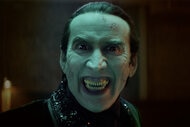Create a free profile to get unlimited access to exclusive videos, sweepstakes, and more!
Yasuke: How the first Black samurai became Netflix's latest anime

In 1579, Alessandro Valignano, an Italian Jesuit who was instrumental in introducing Catholicism to many parts of Asia, arrived in Kyoto, his visit prompting riots in what was then Japan's capital city. The residents were not literally climbing over one another so that they could learn the story and teachings of Christ, but rather they were all desperate to catch a glimpse of the mysterious figure who served at Valignano's side. Standing at an imposing 6'2" with dark skin, Yasuke, as he would be known, was unlike anyone the people of Kyoto had ever seen before.
Scholars differ on his place of birth and how he came to be Valignaro's bodyguard, what is agreed upon is that shortly after his arrival, Yasuke would gain an audience with Nobunaga Oda, one of Japan's most powerful feudal lords, one of three men who unified Japan during the Sengoku period. The two quickly bonded, the daimyo having Yasuke first join him as a bodyguard, later promoting him to the rank of samurai, making him the first foreign-born man to hold the title. He would serve Oda until the lord committed seppuku (ritual suicide) in 1582, to avoid capture or death at the hands of Mitsuhide Akechi, Oda's samurai general turned traitor in what is known as the Honnō-ji Incident.
According to Thomas Lockley's and Geoffrey Girard's 2020 biography, Yasuke was captured by Akechi soon after Oda's fall, the turncoat releasing him because he was not Japanese. The Black samurai would take part in the Battle of Okitanawate, fighting alongside the Jesuit before disappearing from history.
While his time in Japan was short-lived, Yasuke's legacy has endured. Over 400 years since he first reached Japan's shores, the story of Japan's first Black samurai has appealed to creators of various forms of Japanese pop culture, appearing in children's books, manga, period dramas, video games, and even South African fine art. Afro Samurai, the protagonist in Takashi Okazaki's manga of the same name, is said to have been inspired by Yasuke. As for the man himself, until last month, when Netflix premiered an original six-episode adventure fantasy series bearing his name, the samurai had been largely absent from animation, leaving the rest of the world unfamiliar with his story.
In 2011, illustrator, producer, character designer and director LeSean Thomas (The Boondocks, Cannon Busters) first discovered Yasuke's story in a PDF file of author Yoshio Kurusu's 1968 children's book Kurosuke (Black Samurai). Wanting to learn more about this enigmatic figure, Thomas pursued further research, soon realizing that the Black samurai was not someone formed in Kususu's imagination, but an actual person. Upon learning that Yasuke's story ended with the fall of Oda, and that he was relegated to being a side character — an accessory — in his occasional appearances in media, Thomas saw a chance for him to create his own idea of who Yasuke was. He could make Yasuke more than just a secondary character in someone else's story. "We have an opportunity to create a new action hero," Thomas tells SYFY WIRE.
It is fitting that Thomas would end up directing the first anime series based on Yasuke. There are few people in the animation industry with a resume or story quite like Thomas. Born and raised in the South Bronx, Thomas discovered anime at a young age, watching the American adaptations of Macross and Genesis Climber MOSPEADA on television. Initially wanting to make it as a comic book artist, he discovered his true calling when he accidentally purchased a behind-the-scenes documentary on the making of Katsuhiro Otomo's 1988 cyberpunk masterpiece Akira, believing it was a VHS tape of the actual film.
After years of working in the American animation industry, he would journey to South Korea (where the actual animation was taking place). There, he would become the first foreign-born animator to earn a permanent position at Seoul's JM Animation (Avatar: The Legend of Korra). After a brief return to the U.S., Thomas, like Yasuke before him, would travel to Japan's capital city (now Tokyo) and earn a position that many would think improbable due to his background. Only, instead of fighting under a daimyo, Thomas was working in the growing anime industry as both a producer and director.
Yasuke marks Thomas' second full series after 2019's Cannon Busters, and his second for Netflix. He pitched both series to the streamer in 2017, a deal for Yasuke coming a year later, with actor LaKeith Stanfield now on board to voice the lead. It was Stanfield (who apparently arrived at the meeting with a Katana in hand) who wanted Yasuke's journey to be one of self-redemption, fighting not only the mechs, dark wizards, and demons who wish to harm him and Saki — the young but extremely powerful girl who Yasuke protects, reviving his sense of honor — but his own guilt and trauma of losing Oda; the first person who saw him as an equal.
Saki, as well as the other more genre-bending elements of Yasuke (the mechs, wizards, and monsters), came mainly from the third person brought in to work on the series, co-executive producer Steve Ellison, better known as the musician Flying Lotus, who also provided the soundtrack to the series, as well as the opening and closing songs.
Much like Thomas, Ellison has been a fan of anime since childhood. The Grammy-nominated producer has lent his musical talents in a number of anime projects in recent years, his music appearing in Cowboy Bebop creator Shinichiro Watanabe's 2017 short Blade Runner 2049 (and subsequent series) and Watanabe's 2019 Netflix original Carole & Tuesday.
"In my opinion, he's an icon that very few mainstream people know about," Thomas says, "so I was very excited to see what he would bring."
Ellison's involvement with Yasuke started when he was approached by a producer who he had collaborated with on a separate series for Apple TV+, he accepted immediately, only needing to be told that it was a series focused on a Black samurai. For Ellison, joining the project meant he would get to do more than just create Yasuke's sound. He would also get to work alongside Thomas and Stanfield in developing Yasuke's personality, as he would help introduce characters and events to further the series narrative. "Honestly, even if I was just composing music, I would have been just as excited, but to be as involved as I was in something like this, it's a dream come true," he says.
Yasuke's soundtrack, a mixture of Japanese percussion instruments, hip hop, and synthesizers, is a refreshing contrast to the overuse of J-Pop and J-Rock found in a majority of anime series. Working under tighter deadlines than he is accustomed to, Ellison wanted to surprise himself, explore a different sound, deliver something that those who have followed his career since 2008's Los Angeles wouldn't be able to predict.
"I used everything I had, all of my musical knowledge, all my tricks, I used them all," he says, explaining that he would work on the music until "the day would come when they forced me to give it to them." Once he finally got to see the finished product and saw both his music and ideas implemented in creating something unique in a medium he loves, it not only increased his appreciation for anime, it made him want to make more.
"I would love to hang out here for a while," Ellison says, "I feel like it's a perfect space for me to work in right now."
To animate the series, Netflix acquired the services of studio MAPPA (Jujutsu Kaisen, Attack on Titan: The Final Season), which was emerging as one of the anime industry's major hitmakers thanks to the breakthrough success of 2016's Yuri!!! on Ice to animate the series. MAPPA's President and CEO, Manabu Otsuka, would then go out and acquire the series' biggest get, hiring the legendary animator, character designer, and director Takeshi Koike (Redline, Lupin the Third: The Woman Named Fujiko Mine) to work on the character designs.
For Thomas, Koike's involvement gave the artist the opportunity to work alongside one of his anime heroes, who has been spending the last few years directing a series of Lupin the Third stand-alone films. "Everybody's got their own artists that they copy, they got their favorite illustrator, and Koike was that for me," Thomas says.
Thomas' fascination with Koike began after seeing World Record, a short from the 2003 anthology film The Animatrix featuring a Black track and field star pushing the boundaries of the Matrix. "I've never seen a Japanese anime focus for three, five minutes on a Black character before, I couldn't stop watching it." For Thomas, the idea of collaborating with his idol (and even giving him notes) is something he couldn't have predicted when he opened that PDF file a decade ago. "This guy did the pilot for Afro Samurai, how serendipitous is it that he comes back to do the character designs for the anime based on the first Black samurai? It's all too perfect."
Since Netflix has made it their goal to become one of the prime destinations for anime globally, both by purchasing licensing deals with some of Japan's most prestigious studios and producing original series, the results have been a mixed bag. For every Devilman Crybaby and Great Pretender, there is a host of mediocre series that seem to just mix familiar tropes and character types in hopes that enough anime fans won't notice that what they're watching is basically a retread of what was popular one or two years prior.
Yasuke, thankfully, is a series that does not fit into that latter category. It packs a lot of ideas into only six episodes, even if that condensed episode count does leave viewers wishing for more. It's overflowing with style and feels different in ways that go beyond just its trailblazing protagonist. Yasuke, a story inspired by a tale that's more than 400 years old, is something that could only have been made at this moment in time. It's a step forward for Thomas and his creative team, and if they are able to continue Yasuke's journey, it could mark a step forward for anime as well.


























